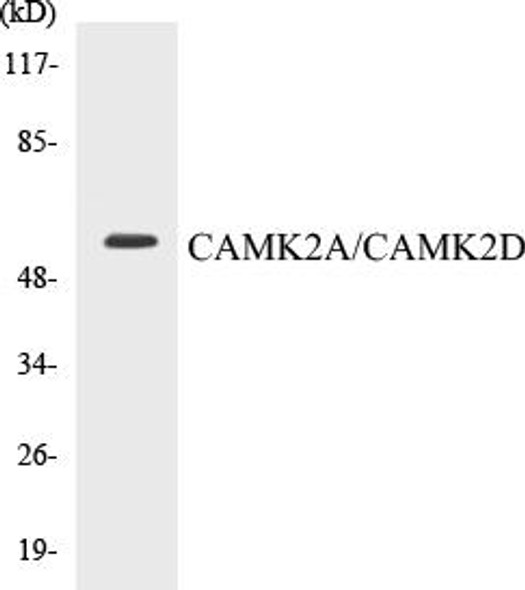Description
CAMK2A/CAMK2D Antibody (PACO03139)
The CAMK2A/CAMK2D Antibody (PACO03139) is a polyclonal antibody designed for research involving CAMK2A and CAMK2D, two calcium/calmodulin-dependent protein kinases involved in various cellular processes. Raised in rabbits, this antibody is highly reactive with human samples and validated for use in Western blot applications.CAMK2A and CAMK2D are key regulators of synaptic plasticity, memory formation, and cell signaling pathways. Their dysregulation has been implicated in neurological disorders such as Alzheimer's disease and epilepsy, making them important targets for research in neurobiology and pharmacology.
This antibody binds specifically to CAMK2A and CAMK2D proteins, enabling their detection and analysis in different cell types and tissues. By studying the function and regulation of CAMK2A and CAMK2D, researchers can gain insights into their roles in physiological and pathological conditions, leading to potential therapeutic interventions for neurological diseases.
| Antibody Name: | CAMK2A/CAMK2D Antibody |
| Antibody SKU: | PACO03139 |
| Size: | 50ug |
| Host Species: | Rabbit |
| Tested Applications: | ELISA, WB, IHC, IF |
| Recommended Dilutions: | WB:1:500-1:2000, IHC:1:100-1:300, IF:1:200-1:1000 |
| Species Reactivity: | Human, Mouse, Rat |
| Immunogen: | synthesized peptide derived from human CaMKIIalpha/delta around the non-phosphorylation site of T286. |
| Form: | Liquid |
| Storage Buffer: | Liquid in PBS containing 50% glycerol, 0.5% BSA and 0.02% sodium azide. |
| Purification Method: | The antibody was affinity-purified from rabbit antiserum by affinity-chromatography using epitope-specific immunogen. |
| Clonality: | Polyclonal |
| Isotype: | IgG |
| Conjugate: | Non-conjugated |
| Synonyms: | CAMK2A; CAMKA; KIAA0968; Calcium/calmodulin-dependent protein kinase type II subunit alpha; CaM kinase II subunit alpha; CaMK-II subunit alpha; CAMK2D; CAMKD; Calcium/calmodulin-dependent protein kinase type II subunit delta; CaM kinase II |
| UniProt Protein Function: | CAMK2A: a protein kinase of the CAMK2 family. A prominent kinase in the central nervous system that may function in long-term potentiation and neurotransmitter release. Member of the NMDAR signaling complex in excitatory synapses that may regulate NMDAR-dependent potentiation of the AMPAR and synaptic plasticity. The holoenzyme is composed of four different chains: alpha, beta, gamma, and delta. The different chains assemble into homo- or heteromultimeric holoenzymes composed of 8 to 12 subunits. May interact with BAALC, MPDZ, SYN1 and synGAP. 2 isoforms of the human protein are produced by alternative splicing. |
| UniProt Protein Details: | Protein type:Protein kinase, CAMK; EC 2.7.11.17; Protein kinase, Ser/Thr (non-receptor); Kinase, protein; CAMK group; CAMK2 family Chromosomal Location of Human Ortholog: 5q32 Cellular Component: cytosol; mitochondrion; nucleoplasm; nucleus; plasma membrane Molecular Function:calmodulin binding; glutamate receptor binding; kinase activity; protein binding; protein homodimerization activity; protein serine/threonine kinase activity; Ras guanyl-nucleotide exchange factor activity Biological Process: activation of NF-kappaB transcription factor; calcium ion transport; G1/S transition of mitotic cell cycle; MAPKKK cascade; peptidyl-serine phosphorylation; positive regulation of calcium ion transport; protein amino acid autophosphorylation; protein amino acid phosphorylation; regulation of neuronal synaptic plasticity; regulation of neurotransmitter secretion; Wnt receptor signaling pathway, calcium modulating pathway |
| NCBI Summary: | The product of this gene belongs to the serine/threonine protein kinases family, and to the Ca(2+)/calmodulin-dependent protein kinases subfamily. Calcium signaling is crucial for several aspects of plasticity at glutamatergic synapses. This calcium calmodulin-dependent protein kinase is composed of four different chains: alpha, beta, gamma, and delta. The alpha chain encoded by this gene is required for hippocampal long-term potentiation (LTP) and spatial learning. In addition to its calcium-calmodulin (CaM)-dependent activity, this protein can undergo autophosphorylation, resulting in CaM-independent activity. Two transcript variants encoding distinct isoforms have been identified for this gene. [provided by RefSeq, Nov 2008] |
| UniProt Code: | Q9UQM7 |
| NCBI GenInfo Identifier: | 296434552 |
| NCBI Gene ID: | 815 |
| NCBI Accession: | Q9UQM7.2 |
| UniProt Secondary Accession: | Q9UQM7,Q9UL21, Q9Y2H4, Q9Y352, |
| UniProt Related Accession: | Q9UQM7 |
| Molecular Weight: | 55,320 Da |
| NCBI Full Name: | Calcium/calmodulin-dependent protein kinase type II subunit alpha |
| NCBI Synonym Full Names: | calcium/calmodulin dependent protein kinase II alpha |
| NCBI Official Symbol: | CAMK2A |
| NCBI Official Synonym Symbols: | CAMKA |
| NCBI Protein Information: | calcium/calmodulin-dependent protein kinase type II subunit alpha |
| UniProt Protein Name: | Calcium/calmodulin-dependent protein kinase type II subunit alpha |
| Protein Family: | Calcium/calmodulin-dependent protein kinase |
| UniProt Gene Name: | CAMK2A |
| UniProt Entry Name: | KCC2A_HUMAN |











